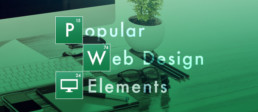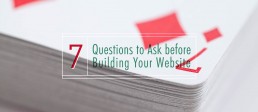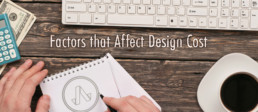Web Development
4 Easy to Avoid Web Design Mistakes
As a small business, your website is of the utmost importance. When visitors make it to your website they are coming for a specific reason and you want to be sure that you can quickly, and efficiently, provide them with a solution to their needs. If your website design is flawed and difficult to navigate, your company could be missing out on a lot of potential leads and ultimately revenue. Here are a few mistakes to avoid in your website design so you can maximize your website’s effectiveness and provide a positive experience to your customers.
1. Understanding Your Target Market:
Many companies make the mistake of not properly understanding their target audience and the different types of customers that fit that description. This often results in web designs that are not optimized and don't work properly for the audience they are trying to attract and engage. Figuring out your target demographic can be extremely helpful in determining the website design approach that works best to give visitors a positive experience while they are using your website.
2. Having an Unclear Call to Action:
What is your goal once users have found your website? Be sure to direct your visitors clearly to this goal. Help show them where the next step is through a concise and prominent call to action. One of the best ways to do this is to first ask yourself what the quickest and easiest way is for visitors to get value from your product or service, then create a call to action (CTA) that helps you quickly give the customer access to that value or collect their data so you can deliver it to them right away.
3. Stale or Boring Content:
Users want your website’s information to be the latest, most up-to-date content available. If your website has very old content that hasn’t been updated, many customers may assume that you are being the times or might not have nice services or products. Additionally, content that is not very valuable, uninteresting, or not engaging can make your visitors lose attention and click away. Work on a way to write your content in a professional but appealing manner that is easy and interesting for your target audience read and stay interested in or want to come back to read more later.
4. The DIY Route:
Your website is the best way for you to interact with your customers. You want to be sure you make your web design, layout, and content choices a priority and make sure there are reasons behind why you made the design decisions you did. A website designed without a professional web and graphic designer involved can potentially lead to mistakes or missed opportunities that result in a loss of revenue due to your customers leaving your site early or not finding what they wanted to, being unimpressed with the design, or not being as engaged as they could have been. A bad design can negatively impact your customers' thinking by making them associate your services and brand with an unprofessional appearance.
These points are just a things to keep in mind to help you avoid a major problem with user experience in your company’s website design and content. It is especially beneficial to make your customers happy and that applies to their experience with your company not just in person but online. If you need some help or have any questions feel free to contact us and we will be happy to help you any time.
If you have questions or are thinking about making a change in your business’ web presence don’t hesitate to contact All in Web Pro for a professional consultation today.
10 Popular Web Design Elements
At All in Web Pro, we're passionate about empowering businesses and brands to reach their full potential using digital technology. It's important that you find a Las Vegas web design team that will help you develop the right kind of website to satisfy the needs of your business or brand. Anyone who has a website or wants to build a new one will benefit from having a better understanding of web design concepts and elements. There are a few different kinds of popular design elements that are being using by many web designers today which you should understand and keep an eye out for. Here are ten web design elements that not only deserve your attention but that you may want to consider including in your next web design venture.
1. Single Page Websites
Many websites you'll find today stack all of their content onto a single webpage, so that most or all of the navigation links send you down the page to the corresponding content instead of taking you to a different webpage address. Doing this has some benefits, including ensuring that regardless of whether a user prefers to scroll down or click first they are always going to be seeing the same content, or at least will be less likely to miss content on a separate page if they only scroll down, or at the bottom of the page if they normally click on links in the navigation menu. This design style typically isn't used for websites with a high volume of content that is better suited to a multi-page website.
2. Parallax animation
Parallax animation, which can be roughly defined as an animation that responds directly to scrolling up or down a webpage, can be a minimal fancy design feature or an integral part of the user-experience (UX). Use of parallax design can create a more fluid and pleasurable experience for a user moving up or down a webpage when done correctly.
3. Cinematic
The names says it all. A website of this genre provides an immediate or large heavily visual experience designed to captivate and engage the audience, often with a full-screen image or video. Users, believe it or not, will judge a web design by its "Book Cover", which is another name for this particular type of web design.
4. Flat design
Don't let its label fool you. Manageable and scalable, flat design is less about the flash and more about the ease of use. This style of design has become dominant over the past few years and is characterized by a lack of texture or depth, and removal of 3 dimensional visual elements. Think of the Windows 8 or 10 layout for example.
5. Background video
Video is the most engaging type of content on social media today. Video has been proven to get more clicks, likes, and shares than photos or text. Adding video as a background element to any website, when done correctly, can add a layer of context and atmosphere that can add to the user's experience as well as the professionalism of a webpage's presentation. It is probably best used on webpages with a minimal amount of other content and layout elements.
6. Tiles
It's not just for the people who like squares and everything in its place. This web design is for online users who are familiar and fascinated with the new Windows 8 interface.
7. Mobile-First
Mobile-first is when a web design is created first to create the best possible mobile experience, and then secondarily adjusted for appearance on desktop screens. Over the past few years a shift took place as mobile internet browsing surpassed desktop use. That means that now the majority of website users are using a phone or tablet to access webpages.
8. Minimalism
Sometimes less is more. A site with this particular web design utilizes small fonts or minimal text within larger visually oriented webpages with fewer navigation options and fewer layout elements.
9. Google Maps Integration
One-touch Google Maps tools allows on-the-go audiences to quickly pull up a location on Google Maps. More and more users are accessing websites through mobile devices these days and helping them find your business quickly and easily is more important than ever.
10. Widget Navigation Menu
Menu widgets are useful elements that keep the navigation buttons in the same location on the webpage regardless of how the user scrolls. This is more for improving the user-friendliness of a webpage than enhancing design aesthetics. With widget navigation, or "sticky menu", audiences will be able to navigate around your website a little more easily and quickly to find the information they need.
Want some insight for how you can use one of these favored elements in your next big website change? Whatever your web design needs, All in Web Pro provides the professional and creative components your website requires.
Save Time & Money by Starting Your Website Right!
How much does it cost to build a great website these days, and what are the most important things to keep in mind, when reaching out to developers and designers for quotes?
How can you hire a team who can work together with you to portray your vision if you are not familiar with the website building process? How can you envision a site that matches your personality and brand? What functions do you need to make it successful and user friendly?
When considering launching your new website, it's easy to get excited and carried away looking at the latest features, functionalities and designs. The truth is many of us have it backwards when it comes to planning and executing these types of projects and here is why:
As consumers, we are used to calling, emailing and researching for packages, costs, evaluating, comparing before deciding on the best solution. Sure, sometimes this is great to get you an amazing deal at an excellent price, but when looking to hire a professional there are a few things to keep in mind.
1. Educate Yourself
The number one thing to keep in mind, is self-education. In order to know what you need for a website you should know what building blocks typically make up a full standard website. Today it is easier than ever to access all the information you could ever need online, which means there is no excuse to not be informed. Taking the time to do a little research by watching informational YouTube videos or instructional articles to understand the basics of domain names, website hosting, and content creation will be very helpful when talking with developers and designers later. Having a basic understanding of common web design terms and components along with an understanding the basics of the web design process will save you time and money.
2. Know What You Need
The second thing to consider is what types of features and functionality you will want or need. Do you plan to sell products and collect payment, allow users to log into your website, or just provide information about your business and allow interested customers to contact you? Finding out which type of website you need is a good start. There are two main types of websites – Ecommerce, Informational, and custom. Within these three categories you can choose from a variety of Content Managment Systems (CMS) that provide even more options. Some of the most popular CMS platforms include WordPress, Joomla, Shopify, Magento, SquareSpace, Weebly, etc. Custom development typically involves programming something from scratch or editing code in an existing program which can be done within existing CMS frameworks or in websites coded from scratch. Getting as much basic information on the most common kinds of functionality options and what CMS frameworks have those features available is key to helping you know how to get the most from your website and choose the right development approach.
3. Have Some Style
The third thing to keep in mind is to know what style of site you need that will fit your business type and brand. Take a while to consider competitor websites. Consider the basic web design concepts being used and relate them to why you like or dislike certain design elements on their website. Ask yourself if the website is easy to use, if important information on the website is easy to find. If you disagree with a design feature, consider what changes would improve a visitor's experience. Once you have decided what you want, move on to the next stage by talking with a professional.
4. Get an Idea of Pricing
The last thing to keep in mind is to what degree different features on your website may affect the price of development. Even if the price may vary drastically depending on the features, different professionals do have different prices and ways to implement your features and designs. And there are a few tools online to help you get a general idea of pricing in general. After you research the first three points we mentioned above and have a good idea of the features you want on your website, you may want to use a website price calculator to give yourself a rough idea of how much your website might cost. Using the link below, select the elements you think you need and the tool will give you a general estimate of what your website might cost. Try using this calculator for starters; click here to visit the Design Quote Calculator.
So how much does it cost to build a website? The truth is that there is no set budget because it depends on what kind of website you're building and who is building it. Also keep in mind that if you do some research you might save yourself a lot of time and money by building your website right the first time. Take your time and have fun researching and learning! You will know exactly what you need for your next website in no time.
7 Questions to Ask Yourself Before Building a Website
Want to build a new website?
Exciting right!? Whether you're planning to hire a web designer or interested in starting a do-it-yourself (DIY) website project, having a smart approach and knowing where to start can save you time and money. We want to help you with this important and exciting process, and have written a few important things to keep in mind to help make your first steps easy and stress-free. Many people can get overwhelmed by the many different options, new terms, and sometimes complicated features they hear about when speaking with web designers. But if you ask yourself a few simple questions you can easily prepare yourself with a strong foundation of the right information to help make your next steps and discussions with any web designers much more productive and efficient.
In this post we've created a list of helpful questions to ask yourself that will help tremendously if you take a little time to answer them before contacting web designers about creating a new website or even if you want to build it yourself:
1. How will your company benefit from a new website or redesign?
- Do you want to increase revenue and online sales?
- Do you want to bring more traffic to your site?
- Do you want to integrate any new features into your website?
- Do you just want your website to be modern and mobile-friendly?
2. Who are your primary audience and target visitors?
- Do you have a younger or older audience?
- Will most of your visitors already know your brand when they arrive, or visit after only seeing an advertisement without knowing much about your brand?
- Are your visitors interested in learning something or taking a specific action?
- What action do you want first time visitors to take?
- What kinds of actions do you want returning visitors or existing customers to take?
- Do you prefer visitors to call you, book something, buy something, sign up for something, or just submit their email address?
3. What content do you need, and what content do you already have?
- How much information needs to be on your website?
- Do you know what pages you want to have, the names of the pages, and text they will contain?
- Do you have photos already, or do you mind using stock photos on your website?
- Do you have any graphical elements to add, and have they already been designed?
- Do you already have a logo designed?
- Do you need any custom graphics or icons to communicate your message?
4. Do you have your domain, hosting, or company email already?
- Have you thought of or purchased a domain for your website yet?
- Have you decided what hosting company to go with and what type of hosting you'll need?
- Do you have a company email setup with your domain name in it?
5. Have you researched what your competition is doing?
- What kind of website are they using?
- How does their content compare to what you want on your site?
- What 'calls to action' (CTA) do they use?
- What products or services do they emphasize most?
- What is the structure and sitemap of their website?
- What special features or functionality does their website use?
6. How will you market your website & drive visitors to it?
- Will you continually update your content to provide new valuable content for visitors?
- Will you use social media activity and networks to drive people to your site?
- Will you use online, print, radio, or TV advertising to drive traffic?
- Do you want to pay for Search Engine Optimization (SEO) to rank well in Google?
- Do you need traffic right away or are you happy to have traffic grow slowly as you add more content to your website or social media streams?
7. How Do You Measure Success and Optimize For It?
- Are you considering site traffic monitoring systems?
- Do you want to track ROI for conversions per advertisement?
- Will you try to track total sales, or be able to identify sales from different channels?
- Will you use outside sales and marketing subcontractors, or your own in-house team?
For measuring advertising performance and optimizing to improve it, you may want to consider strategies such as A/B testing, SEO, Content Generation, Ad Conversion Tracking, asking leads how they heard about you, using and comparing multiple channels to drive traffic from social media and online content distribution networks, in addition to traditional print, radio, & TV placement.
Don't be afraid to ask for help.
Be sure to keep these tips in mind when you're considering building your next website. You will be much more prepared if you take a few minutes to consider each question, learn what the terms mean if any are new to you, and don't be afraid to ask more questions. If you have get stuck on any of these questions, or feel want to have someone double check your answers, feel free to reach out to a professional at anytime!
All in Web Pro is here to help when you need us. Feel free to leave a comment below, or give us a call at our Las Vegas office at 702.331.0650!
Choosing a Web Development Company
Unless you know exactly what you’re looking for, choosing a web developer in Las Vegas can be a difficult task. There are no licensing requirements for web developers and the barriers for entry are almost nonexistent. This has caused the web development market to become flooded with freelancers and companies of all skill levels, experience and capabilities. In this article, we’ll give you five tips for finding the perfect Las Vegas web development company for your next project.
Find a specialist
Many web developers claim that they can do it all. In reality, most web developers are primarily either graphic designers or programmers. Both of these fields are very specialized, and it’s uncommon to find people who are experts in both. When looking for a web developer in Las Vegas, we suggest asking them who will be doing the graphics and who will be providing the programming work. If it’s the same person doing both pieces, we advise paying even closer attention to their previous work and their portfolio.
Check their portfolio
A web developer’s portfolio is a good indication of the type of work you can expect from them for your own website. When reviewing their portfolio, keep an eye out for aspects that you want to be incorporated into your website. If you are looking for the latest in design trends or cutting-edge technology, look for those types of designs in their portfolio. On the other hand, if you’re looking to have a website developed that involves complex programming, ensure the developer has examples of this as well.
Will their website be SEO friendly?
In the early days of the internet, simply having a website was enough to be found by both current and potential customers. In 2016, having a website is just one aspect of your overall web presence. It’s important to make sure that the web developer will create the site with SEO (search engine optimization) in mind. This will help you increase your rankings in search engines and make it easier for customers to find you.
Long term
Another thing you should consider when choosing a web developer in Las Vegas is the scope of ongoing maintenance and the charges this will incur. It’s also important to understand at what point your initial projects ends and the maintenance phase of your relationship begins.
Communication
Once you’ve narrowed your web developer choices down, it’s a good idea to speak with the developer directly. This will help you understand how well they communicate and it’s a good indication of how they manage client relationships. It’s also one last measure of safety before you have the developer begin working on your project.
All in Web Pro is the premier web design and development company in the Las Vegas area. We focus on providing custom web design and development solutions to the Las Vegas area and beyond. Whether your project is a blog or business website, we can take your web presence to the next level.
Important Factors that Affect Your Web Design Cost
3 Factors that Affect Your Web Design Cost
One of the questions we receive a lot of is “how much will my website cost?”. This can be very difficult to answer because of the many different types of websites and time it takes to build each one. There are some major factors that can change the price of your website which we have compiled in this article:
1. The components and features you need.
Never assume that your needs are “simple” or should be cheaper than a designer’s standard rate. Some things look easy but are very complicated, while others seem like a big deal but are very easy to implement. Your site may only consist of a single page, yet that doesn’t mean it’s automatically cheaper than one with 5 or even 100 pages.
The thing is, that even if something is simple for a designer to handle it has taken years for them to learn that skill much like a doctor or attorney. Additionally, things can require custom development during construction which may necessitate additional time to either create or troubleshoot a unique component. Generally the more custom features, graphics, functionality, and components you request that are unique to your site the more it will likely cost.
2. Your designer’s skill level.
Yes, you can get a website for $150. No, it won’t be the same quality as a website that costs $1500. It’s like the difference between a bicycle and a Lexus. Both will get you where you need to go, but one is decidedly faster, provides a more comfortable user experience, and requires less effort for a user to operate than the other.
Designers who charge more are typically providing you with expertise you won’t find at a bargain rate – and in most cases, the value of the benefits will certainly outweigh the added costs. If you automatically choose the cheapest option, you risk hiring a designer who may have poor communication, an unclear process, inconsistent follow-through, no support after completion, or a sub-par or faulty end product. Don’t say we didn’t warn you!
This goes for the same as using a build-it-yourself site like Wix or SquareSpace. You can get a nice looking site but you may end up spending a hundred hours to do it and have a website that is missing important elements or that is not organized, modern, or user-friendly.
3. How demanding you are as a client.
In the interest of being honest, I’ll share a tidbit that can add to the cost of a website. If you as a client are not organized in advance and don’t have your project information like initial vision or revision request organized, succinct, and collected into one easy to read document, it will most likely slow down communication, require extra time to be spent in follow-up conversations to clarify your feedback, and will take time away from both yourself and the company you hired, ultimately delaying the final completion date of the project and potentially costing you more money.
Over time, designers learn how to identify challenging clients, and although we take many precautions to ensure our design & development processes are clear and straightforward, we also make sure that we are compensated for any extra work caused because of a highly demanding client. Please remember that designers also have lives away from our computers a healthy long lasting business to business relationship works both ways.
Like lawyers, depending on the project, graphic designers and web developers have the ability to bill clients for time spent on rushed projects that require work outside of regular work hours, or even for time needed to meet, call, or email with a client depending on the type of project and service agreement in place.
As a client the best thing you can do is allow your designer the time he or she needs to complete the list of work they currently have and not make edits in the middle of a project, especially if it isn’t going to be finalized yet. Also, it’s extremely important to follow the procedural instructions of your designer or developer. If they require all revisions or information to be submitted at that time, it’s important to spend the time necessary to have your information prepared so that no surprise changes need to be made near the end of the project that should have been brought up in the beginning.
So How Much Should I Pay?
Good Question. A good website on the low end will probably cost anywhere between $3,000 and $5,000. This is a very rough estimate for basic but good quality informational website for a business. From there the cost can go up depending on how many additional features, components, custom work, or special considerations you are requesting. If you are looking to only spend $2,000 or less, you may as well just use a do-it-yourself web editor, or use a creative solution such as forwarding your domain name to a simple business listing page like your Google Places or facebook page until you have enough time and money to invest in a professionally built website. For another rough estimate of web design costs, feel free to use this web design pricing calculator for a general example of how prices change as more features are added to a website quote.
Interested in getting some web development done? Contact our team at All in Web Pro today!
5 Steps to Take Before you Build a Website
You’ve decided to get a website. Terrific! You may be asking yourself “now what?”. It can be tempting to jump right into choosing a template or design you like and running full steam into the development process. Although this is tempting there are proven steps that will help your website development process go easier.
These five steps will ensure you have a final product you can be proud of and that accurately represents your company or organization.
Step 1: Plan Your Text
Text (or web copy) is the backbone of your website. It can attract clients if presented the right way or it can scare them off when it lacks focus or has typos. Paying close attention to what you write and how you write it can make a huge difference. Think of an average reader, then use clear and accessible language in your writing so that everyone can understand it easily.
Write the content for your pages before you contact a web developer. By writing and re-writing your content you will be able to determine exactly how you want people to see your business before any design is ever done.
Step 2: Choose a Company Name and URL
If you haven’t yet chosen a name for your company, think about what your URL will look like. You don’t want a website that reads "joesfunkyandawesomeshirts.com". Short, clear names are easier to understand and look great online. Choose a name that is simple and short with a meaning that you can brand and stick with.
Stay away from picking a company name just because it has a keyword you want to target, instead go for branding and let the keywords take care of themselves. And if you’ve already chosen the name of your company, there are still several variations of the name of your company and for the domain extension you choose (.com, .co, .vegas) that can give you the best domain name and online brand possible.
Step 3: Choose a Color Palette and Logo
Once you have a name picked you will want to decide on colors for your brand and a logo. Having a designer create your logo is well worth the effort as that can make you look much more professional than if you were to create one on your own.
Colors mean different things and talking to a designer can help you find a color scheme that works for your website and logo. Be careful to pick colors and designs that you can use for print advertising, vehicle wraps, letterhead, online media, etc.
Step 4: Choose and Use Great Photos
A business website requires different photos: photos of your products, a portrait photo for the ‘about’ or ‘bio’ section, an introductory photo for your home page, etc. Since we’re living in the age of images, you need to choose your images carefully and make sure they’re high-resolution and the best possible quality. Stock photos can work but if you have the ability, have custom photos taken by a professional photographer. Much like the logo your photos have the power to make your website stand out and impress visitors.
Step 5: Research Rinse and Repeat
This could very well be step 1, but researching is important through the entire stage of building a website. Look at competitors to see what you like and don’t like about their websites. Make lists of important pages, content, calls to action, and features that you want on your site. Ask other professionals in your field and your past clients what would like to see on your website. Getting input from trusted and relevant sources can be invaluable in the decisions you make about your website’s design.
For help with your next web project contact us at All in Web Pro at 702-331-0650!
Responsive Design & Why it is Important
/** This is an example of a media query that will activate if your screen has a width of up to 680px; It will then (and only then!) apply the contained CSS. */
@media screen only and (max-width: 680px) {
.someGridElement { max-width:50%; }
}
/** The below media query only applies to view sizes above or equal to 680px width.* Setting it to 681 is so that we don’t have overlapping rules.*/
@media screen only and (min-width: 681px) {
.someGridElement { max-width:25%; }
}
Dynamic Website Application Development with Node.js
var http = require('http');
http.createServer(function(request, response) {
response.writeHead(200, {'Content-Type': 'text/plain'});
response.end("Testing!");
}).listen();
This example is about as simple as it gets, but it can get a lot more complex. Some larger websites that are built on node are walmart.com, LinkedIn, Yahoo, and even Uber.
Get Started with NodeJS:
Creating a Good User Experience
- Get feedback from friends, family, A/B testing, page analysis tools, and anything else you can get your hands on. These are crucial for any high-end or high traffic web design project.
- Keep your design consistent. Reuse design elements to give a sense of unity. This means, stick to your colors and light/darkness percentages.
- Make tasteful use of animation. Tasteful is hard to define, and it is ultimately left up to you, but find an animation that works for you and the functions that your application performs. Smooth movement is great eye-candy, and will reinforce the feeling of completed an action or creating a sense of progress as users navigate through your site.
- Make use of load times, but keep them short. Having an animation or smooth transitions will reduce the perceived load time, and making things load quickly will help retain users and make sure that they do not get bored or impatient.









